
When he was 11 years old, Neil deGrasse Tyson took an astronomy class at the Museum. His head has been in the cosmos ever since. Find out how he studies objects that are too far away to visit or see with the naked eye.
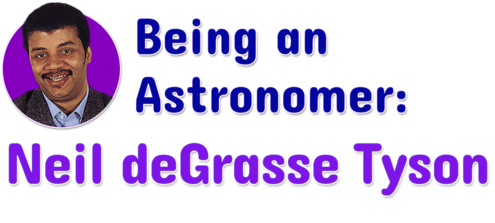
When he was 11 years old, Neil deGrasse Tyson took an astronomy class at the Museum. His head has been in the cosmos ever since. Find out how he studies objects that are too far away to visit or see with the naked eye.
1. What do you remember about your first visit to the Hayden Planetarium?
Neil deGrasse Tyson: I was nine years old when I first visited the Hayden Planetarium and I felt as though I could see forever. In the Planetarium's starry dome I saw thousands of stars , essentially an uncountable number. And I was pretty convinced that it was a hoax - that it couldn't be the case! I know how many stars there were, because I'd seen them from the Bronx, New York, where I'd grown up. Which was the real sky, the thousand-star-studded sky of the dome, or the sky I recognized? That conflict got me started.
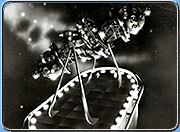
Projector from the Museum's old Hayden Planetarium
2. As a kid, what did you do when you wanted to learn more about space?
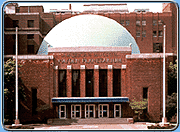
The Museum's first Hayden Planetarium
Neil: When I was eleven, I took my first course at the Hayden Planetarium on astronomy and astrophysics. Most of the material was over my head, but that didn't matter. What I did learn was that the science I was interested in requires real math, real physics. So at eleven I began to shape my life so that I could get that math and physics background. It changed my study of the universe from an exercise in simply looking up to an exercise in learning about the forces and laws of nature.
3. Did you ever go to space camp?
Neil: No, I went to astronomy camp in Arizona, when I was fourteen - my first real trip away from New York City's light and air pollution. That's where I noticed that in fact the real sky was a pretty good approximation of the one I saw in the Hayden Planetarium. Space camp today is actually for training to be an astronaut. I never wanted to be an astronaut.
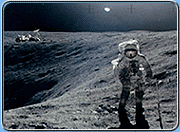
Astronaut on the Moon
4. How come you never wanted to be an astronaut?
Neil: Because astronauts just went into orbit 200 miles above Earth's surface, no farther than Boston is from New York City. At best they went to the Moon. I was fascinated by the space program and I still am. But my scope, my sense of what I wanted to do in life, extended to the outer reaches of the universe.
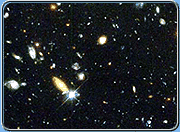
Hubble Space Telescope view of deep space
5. What's the difference between an astrophysicist and an astronomer?
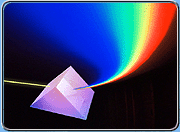
Light divided by a prism
Neil: In fact there's no difference. It's just that astrophysics reasserts the role of physics in understanding how the universe works. In the late 1800s we learned that light from the universe could be analyzed with a prism, which allowed us to figure out all sorts of things about planets, stars, and galaxies , especially their chemical composition and whether they are in motion through space . From then on, scientists began to think about the universe as it related to the laws of physics.
6. How did your stargazing career begin?
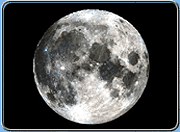
The Moon
Neil: I was about eleven when a friend of mine lent me a pair of binoculars. I'd used them at sporting events, but my friend encouraged me to look up. That's when I saw the Moon for the first time. It wasn't just bigger, it was better. It was a world unto itself. This object that floats above us, that we all take for granted, became a place that I could imagine being, because I saw the mountains and valleys and craters. I thought to myself, if binoculars could do this what could mountaintop telescopes do? And you know, 15 years later I was using mountaintop telescopes, which was an immeasurably bigger and better experience.
7. When did you get your first telescope?
Neil: I was in seventh grade. It was a birthday gift from my parents. It wasn't one of these wishful gifts that parents buy after thinking, "Oh wouldn't it be great if Junior gets a chemistry set to get him interested in chemistry." No, I'd already demonstrated a strong interest in the universe. It was a simple telescope , I think it cost $50, but that's all you need to show real details on the Moon's surface or the rings of Saturn.
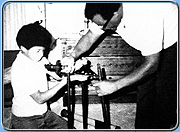
Neil with his first telescope
8. Why is Saturn your favorite planet?
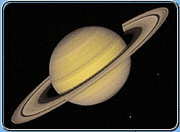
Saturn
Neil: Oh, it's the most beautiful thing out there. No matter who you are, no matter your state of mind, if you look at Saturn your mouth drops open. If life ever gets you low, just pull out a telescope and look at Saturn. You say, "My gosh there's a world out there, with a ring around it - how cool can you get!"
9. How did you meet other amateur astronomers?
Neil: Through the Amateur Astronomers Association of New York. Anyone can join, at any age, as long as you're interested in the universe. A telescope can come later. I happened to join when I was thirteen and attended all their observing sessions, which are called "star parties." The dues at the time included a subscription to Sky & Telescope magazine, which is a hobbyist's dream. There, in this magazine, appeared article after article about my favorite subject. Most cities in the country have organizations of amateur astronomers. To be an amateur astronomer is actually a badge of pride.
10. What's the hardest thing to explain about the universe?
Neil: The hardest thing, I think by far, is how we analyze spectra — light broken up into its component colors. It's so abstract, so removed from the actual object we're studying. See, chemists can study actual chemicals in the lab. Biologists can study actual plants. But astrophysicists can't go out there and grab a piece of a galaxy and put it in a laboratory. We have to study a picture of the thing, and then analyze the light that comes from it. Ninety-nine percent of everything we know about the machinery of our universe comes to us through the analysis of light.
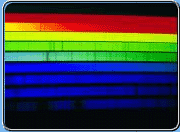
Spectra of light
11. How are new technologies changing what we know about the universe?
Neil: Advances in our knowledge of the universe have always marched in step with advances in technology. For example, fifty years ago, there was only one view of the universe, and it was through the visible part of the spectrum of light. But now, every window of light in the universe is now open to us. We now have telescopes on Earth and in orbit that are sensitive to gamma rays, X-rays, ultraviolet, infrared, microwaves, and to radio waves. It's all just light - it just happens to be invisible to the naked eye.
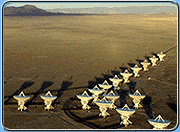
radio telescopes
12. What would the world look like if we could see invisible light such as radio waves?
Neil: Completely different. If you could tune your eyeballs to see radio waves, the antennas on top of tall buildings would be aglow from TV and radio broadcasts. If you could tune your eyes to microwaves, then the police officer standing on the edge of the highway with a radar gun would be the brightest thing on the horizon. If you had infrared eyes you'd see people glowing from their body temperature. Visible light is such a tiny slice of the whole spectrum that we are essentially blind. New telescopes can see these other kinds of light and tell us amazing things about the universe.
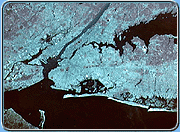
New York City in infrared
13. What does light tell us about the universe?
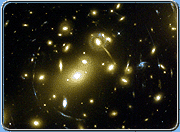
faraway stars
Neil: Different objects and phenomena in space give off different kinds of light. And that light tells us all kinds of things: what an object is made of, how old it is, whether it's moving towards or away from us, whether it's spinning. Studying the light from these distant objects is the most fundamental way we know anything about the universe.
14. Does it bug you that you can't get closer to the things you study?
Neil: No, it's the very nature of the subject. I mean, if you were frustrated by the distance, you wouldn't be studying astrophysics, you'd be studying some tabletop science. Part of the fascination is that you can't touch it. It's quite humbling. You can't interfere with it, you can't pollute it, you can't change it. It's like fishing - you're just sitting there, hoping the fish will bite your bait. I'm just sitting there passively gathering light that was emitted by stars in a galaxy millions of years ago.
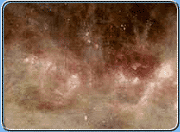
Milky Way as seen from Earth.
15. How has the space program changed astrophysics?
Neil: The space program enabled us to visit the solar system as though it were our backyard. It transformed the solar system into a laboratory, mainly because now we can make little robots that get up there faster and easier and don't have to be brought back. But that's just nearby.
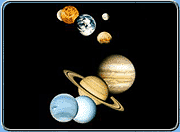
The planets of our solar system
16. What question do you get asked most often?
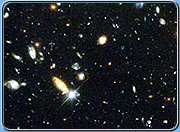
Hubble Space Telescope view of deep space
Neil: The number one question is, "Is there life elsewhere in the universe?" Given the sheer scale of the universe, and given how quickly life formed on Earth, and given that life is made out of the most common ingredients in the universe, there's no question that life exists elsewhere. It took only 200 million years - just 4% of Earth's total history - to jumpstart life. History has shown us that the more we think we're special, the more we find out we're not. So get used to it!
17. Are there many women astrophysicists?
Neil: Yes, more than in most of the physical sciences. Astrophysics has a rich history of contributions from women that goes back a hundred years. Once we realized you could learn about stars from gathering their spectra, people started getting spectra of hundreds of thousands of stars in the nighttime sky. Somebody had to coordinate and analyze all the data. That was considered low-level work, and the men wouldn't go near it. So they hired rooms full of women to do it. They were known as computers, before machines existed to do the counting. Many of these women were smart and careful enough to recognize certain patterns and regularities. And that effort was the birth of our modern understanding of how stars work, which is a cornerstone of twentieth century science.
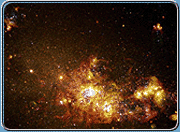
stars being formed
18. You study the structure of our galaxy, the Milky Way. What makes this hard to do?
Neil: The Milky Way is our home, and it's very difficult to know the structure of something if you're embedded within it. It's as difficult as an unborn child trying to figure out what its mother looks like. Imagine one of the blueberries in a blueberry pancake. If the pancake is our entire Milky Way Galaxy and the Sun was in the center of the blueberry, the farthest we can see is the edge of the berry. So we use radio waves and other techniques that can penetrate through the pancake (through the galaxy) to try to see what's out there.
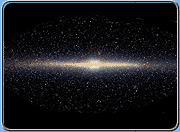
Milky Way seen from the side
19. What are some tricky questions astrophysicists wrestle with?
Neil: Oh, big, grand questions like, will we expand forever, what's the shape of the universe? That sort of thing. But there are some questions that hit home. For example, when is the next asteroid going to hit Earth? But people shouldn't worry about the next collision, 'cause when it happens you'll be dead. If it doesn't happen, you'll be fine. I'm not worried, it's just part of the cycle of life. An asteroid took out the dinosaurs 65 million years ago and enabled the mammals of the day to rise up from the underbrush and lead to species that today include humans. We're here because of an asteroid.
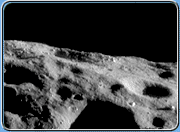
Surface of asteroid Eros
Image Credits:
Photos: Neil de Grass Tyson Pages: Neil de Grasse Tyson: courtesy of Neil de Grasse Tyson; Astronaut on the moon: courtesy of John W. Young, Apollo 16 Crew, and NASA; Light divided by a prism: courtesy of Concept Images, 1998 Noriko all rights reserved; Hubble Telescope View from Deep Space: courtesy of R. Williams and the HDF Team (STScI) and NASA, Hubble Deep Field; Spectrum of light: courtesy of AURA/NOAO/NSF "Copyright Association of Universities for Research in Astronomy Inc. (AURA); all rights reserved." Infrared Hudson river view: courtesy of NASA; Radio telescopes: courtesy of Dave Finley, AUI, NRAO, NSF; The Moon: courtesy of NASA, Galileo; Saturn's Rings: courtesy of JPL, California Institute of Technology and NASA, Voyager 2; Milky Way as seen from the Earth: courtesy of Jayanne English (STScI) et. Al., CGPS, RAL/U. Calgary, APOD; Surface of Io: courtesy of University of Arizona, JPL/SSI and NASA, Galileo; Stars: courtesy of STScI, The Hubble Heritage Team and NASA; Planets: courtesy of NASA; Projector and Hayden Planetarium: courtesy of AMNH Department of Library Services; Kids: All people pictures: courtesy of subjects; Jupiter: courtesy of PDS/JPL and NASA, Voyager 1; Illustrations: All drawings: courtesy of subjects




 Biodiversity
Biodiversity
 Brain
Brain
 Genetics
Genetics
 Marine BiOLogy
Marine BiOLogy
 MicrobiOLogy
MicrobiOLogy
 PaleontOLogy
PaleontOLogy
 ZoOLogy
ZoOLogy
 AnthropOLogy
AnthropOLogy
 ArchaeOLogy
ArchaeOLogy
 Astronomy
Astronomy
 Climate Change
Climate Change
 Earth
Earth
 Physics
Physics
 Water
Water
